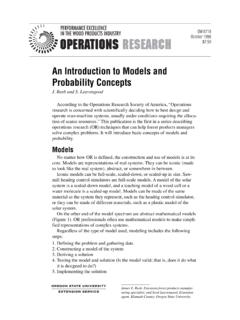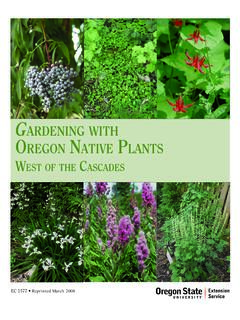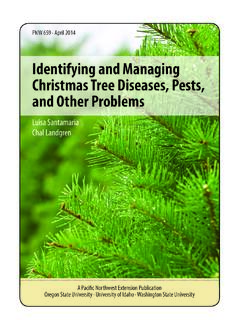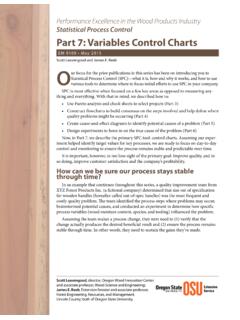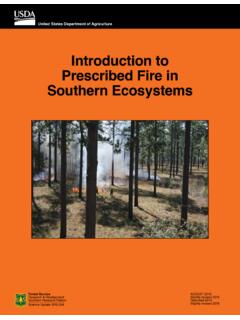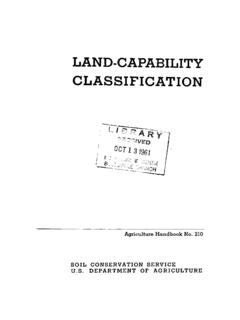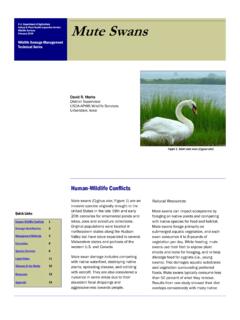Transcription of Pacific Northwest's Least Wanted List: INVASIVE WEED …
1 Pacific Northwest's Least Wanted List: INVASIVE WEED. IDENTIFICATION. AND MANAGEMENT. OREGON STATE UNIVERSITY EC 1563. EXTENSION SERVICE. June 2003. $ Sepal The outer, leaflike part of a flower. Weed Terms Serrate Saw-tooth with forward-pointing teeth. Apex (pi. apices) The tip. Silique An elongated capsule with two separate Auricle A small, ear-shaped lobe or appendage. valves. Awn A slender, usually terminal bristle. Spikelet A flower cluster in grasses consisting of usually two basal bracts and one or more florets. Axil The angle between a leaf and stem. Stipule One of a pair of appendages at the junction Bract A small, leaflike structure below a flower. of a leaf petiole and a stem. Disk flower A tubular flower. Stolon A horizontal stem that roots at the nodes. Glabrous Smooth; without hairs. Surfactant A product commonly added to herbi- Inflorescence The flowering part of the plant.
2 Cides to improve the wetting, emulsifying, spreading, Ligule A thin, membranous outgrowth or fringe of or dispersing properties. hairs from the base of a grass blade. Trifoliolate With three leaflets. Ocrea A sheath around the stem above the base of Umbel A flat or rounded flower cluster with all the leaf. stalks radiating from a common center. Panicle A loose, irregularly compound flowering part of a plant with flowers borne on individual stalks. Use Herbicides Safe/. Petiole A stem or stalk of a leaf. Wear protective clothing and safety devices Pinnate Arising from several different positions as recommended on the label. Bathe or along the side of an axis. shower after each use. Raceme An arrangement of flowers along a stem on Read the herbicide label even if you've individual stalks about equal in length. used the herbicide before.
3 Follow closely Ray flower Marginal petallike flowers. the instructions on the label (and any other directions you have). Rhizome An underground stem, usually lateral, sending out shoots above ground and roots below. I Be cautious when you apply herbicides. Rosette A compact cluster of leaves arranged in an Know your legal responsibility as a pesti- often basal circle. cide applicator. You may be liable for injury or damage resulting from herbicide use. Senesced Dead. By Jed Colquhoun, Extension weed specialist, Oregon State University. Cover photo: Three INVASIVE species that dominate the landscape scotch broom (with yellow flowers), Himalayan blackberry (background), and slender false-brome (foreground, bottom left comer). Pacific Northwest's Least Wanted List: INVASIVE Weed Identification and Management INVASIVE weeds reduce not only crop yield, but also Introduction crop quality.
4 In Oregon, cleaning of seed crops con- taminated by INVASIVE weed seeds represents a major What is an INVASIVE weed? cost of production. INVASIVE weeds are plants that have been introduced All of these impacts are eventually passed on to con- into an environment outside of their native range. In sumers as higher product costs. their new environment, they have few or no natural enemies to limit their reproduction and spread INVASIVE weeds reduce biodiversity and (Anonymous 2002). INVASIVE weeds affect us all displace native plant and wildlife species. farmers, homeowners, taxpayers, consumers, and INVASIVE weeds are considered to be the second most tourists. important threat to biodiversity, after habitat destruc- Several INVASIVE weeds also are considered noxious tion (Westbrook 1998). Two-thirds of all endangered weeds. Noxious weeds are nonnative plants that have plant and animal species are threatened by nonnative been legally designated as serious pests because they competitors.
5 In many areas of the Pacific northwest , cause economic loss or harm the environment. Or- INVASIVE weeds such as yellow starthistle and egon, Washington, and Idaho each has a state-desig- cheatgrass now grow in monoculture (solid stands) on nated noxious weed list that changes over time as ground that was previously diverse and productive in weed invasions occur. Some, but not all, of the cur- plant species and wildlife. rently designated noxious weeds are included in this INVASIVE weeds reduce land values. publication. The value of cropland often is reduced by INVASIVE species such as leafy spurge and Himalayan black- Why should we care about INVASIVE berry. In Klamath County, Oregon, for example, leafy weeds? spurge is so prolific in some areas that cropland has been abandoned. INVASIVE weeds reduce crop yield and quality. INVASIVE weeds inhibit recreational Five hundred introduced plant species have become activities and tourism.
6 INVASIVE weed pests in agriculture. About 73 percent Much of the land used for recreational and tourist of agricultural weeds are nonnatives. Crop losses due activities is publicly owned. Thus, the cost of INVASIVE to nonnative weeds are estimated at $24 billion per weed management often is passed on to taxpayers. year. Additionally, $3 billion worth of herbicides are INVASIVE weeds such as gorse and Himalayan black- applied each year to manage INVASIVE weeds. berry act as physical barriers that prevent the use of Ranchers alone spend about $5 billion per year on land for recreational activities. weed control, but INVASIVE weeds continue to spread Weed management in the turf industry is very costly. rampantly in range and pasture land (Pimentel 2000). It has been estimated that $500 million per year is INVASIVE weeds have spread over 17 million acres of spent on INVASIVE weed control in residential turf and public rangeland in the western United States at a $ 1 billion per year in the golf course industry rate of 4,600 acres per day.
7 The culprits, including (Pimentel 2000). Common dandelion, for example, leafy spurge, yellow starthistle, and medusahead, are was introduced to North America as a salad green in unpalatable or even toxic to livestock (Westbrook the 1600s, but is now ubiquitous in American lawns. 1998). INVASIVE Weed Identification and Management INTRODUCTION. INVASIVE weeds impede water flow, reduce Prolific reproductive capabilities both as seed water availability, and increase soil erosion. and as vegetative tissue (roots, rhizomes, etc.). INVASIVE weeds such as purple loosestrife can impede Long seed life in soil or water water flow in irrigation canals and streams, thus reduc- Rapid early growth and expansion of a root system ing the amount of water available for irrigation and increasing the risk of flooding. Other weeds deplete Rapid and early maturation water resources used by native plants and wildlife.
8 Tolerance of low resource levels ( , nutrients Saltcedar (tamarisk), for example, can use up to and water). 200 gallons of water per day. Absorption of excessive levels of nutrients and Invasion by weeds that have shallow root systems water that otherwise would be used by neighboring increases soil erosion on slopes and stream banks. plants English ivy has a very shallow root system and does Genetic and environmental adaptability that not protect erodible soils. ensures survival in a variety of climate, soil, and INVASIVE weeds cause fire hazards. environmental conditions Dormant or senesced INVASIVE weeds provide fuel for Ability to adapt to management strategies ( , to wildfires. Cheatgrass, or downy brome, increases fire develop resistance to herbicides). frequency from once every 60 years to once every 3 to 5 years. Restoration and fire management in cheatgrass-dominated lands cost taxpayers millions of dollars per year.
9 In 1936, gorse provided the primary General weed management fuel source for a fire that burned the town of Bandon, techniques Oregon. Gorse is highly flammable and grows in densely populated coastal areas where property values Cutt/ng/mow/ng are high. Cutting or mowing plants effectively controls some Some INVASIVE weeds are toxic to animals weeds, while stimulating regrowth and branching of other species. In general, control often is greatest and humans. when weeds are young and with species that branch Several INVASIVE weeds are not only unpalatable to above the point of cutting or mowing. Low-branching livestock, but also can be toxic. The milky sap of leafy species often grow multiple shoots from a single cut spurge, which dominates a large portion of pasture and branch, thus increasing the reproductive potential rangeland in the western , irritates cattle's eyes, and competitiveness with desirable species.
10 It often is mouth, and digestive tract. important to remove plant material from the site after INVASIVE weeds that are poisonous to humans are not plants are cut or mowed to prevent resprouting or uncommon. Giant hogweed, a weed found in residen- weed seed production. tial areas, ironically was introduced as an ornamental. Unfortunately, the sap is an irritant that, when com- Manual removal bined with exposure to sunlight, causes severe skin Manual removal of annual weeds, particularly when blistering. they are seedlings, can effectively limit their estab- Why are some nonnative plants INVASIVE , lishment when they are confined to small areas. This while others are not? management technique is limited by the size of the infested area relative to what can be practically The most successful INVASIVE weeds share several bio- removed by hand.
